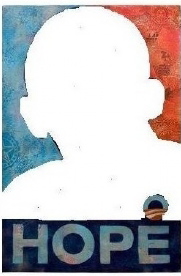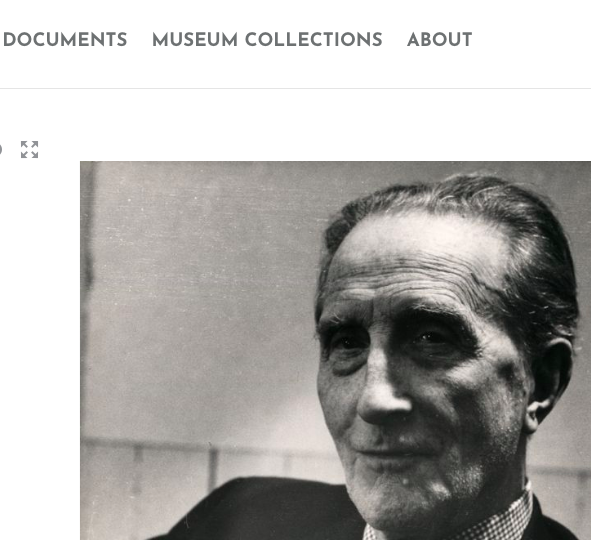
Fine Art News has an interesting pro-copyright article by Brian Sherwin. Sherwin calls the post-Cariou copyright decision the birth of the “new art movement,” De-Appropriation Art. Funny and witty? Yes, but of further import is his representation of appropriation art works be de-appropriated. Take a look at the images here. It’s hard to argue that the de-appropriated versions of Garnett’s, Prince’s, and Fairey’s infringing works are not actually better, in every sense of the word.
The de-appropriated versions are much more poignant and critical not only of copyright law, but more so of the subject matter they represent: guerrilla movements, painting, and of course, the by now obvious vacuum that is Barack Obama. In Garnett’s and Prince’s de-appropriated version, direct — and insightful — connections can now be made to the work of Gerhard Richter and Robert Ryman. And in fact, the Obama “blank/white” image is very timely, signifying not only the empty rhetoric of the last two years, but more so the absence of any “hope.” What’s left in the empty blank/white image is nothing but a logo, a trademark referencing the services and products of a shell with no substance, and by fiat, the manipulation of a willfully ignorant consumer base.
After all the hoopla (is it over yet? **yawn**), all that’s left is a six-mile trip next May to the new building down the street from the Philadelphia Museum of Art. So, how do you move a $25 billion dollar collection? For one thing, you don’t make it easy for thieves.
We would love to see the written agreements and insurance documents for this move.
June 25th, 2011 by Sergio Muñoz Sarmiento in
Education
As America’s wars in Afghanistan and Iraq start to wind down, an artist focuses on the home front, and the personal battles of the thousands of wounded veterans coping with their disabilities.
Via the BBC.

Courtesy of and copyright by Esther Kirby. Everystockphoto.
The Comic Book Legal Defense Fund announced today that it is forming a coalition to support the legal defense of an American citizen who is facing criminal charges in Canada for comics brought into the country on his laptop. If convicted, the American citizen, whose name is being withheld by his attorneys, could result in a mandatory minimum sentence of one year in prison.
According to the CBLDF, upon arrival at Canadian Customs a customs officer conducted a search of the American citizen and his personal belongings, including his laptop, iPad, and iPhone. The customs officer discovered manga on the laptop and considered it to be child pornography.
According to the CBLDF, “[t]his incident is the most serious in a trend the CBLDF has been tracking involving the search and seizure of the print and electronic comic books carried by travelers crossing borders. CBLDF Executive Director Charles Brownstein says, ‘Although the CBLDF can’t protect comic fans everywhere in every situation, we want to join this effort to protect an American comic fan being prosecuted literally as he stood on the border of our country for behavior the First Amendment protects here, and its analogues in Canadian law should protect there.'”
More on this story via the CBLDF here.
Not too much going on art law wise this summer (at least so far), but there is an interesting copyright law case that will be heard this fall by the US Supreme Court. Interestingly, it is rare in that it does not deal with fair use.
The case, Golan v. Holder, basically asks whether a congressional act violates the First Amendment when the act grants copyright protection to foreign works that were previously in the public domain in the United States. The ACLU has just filed an amicus brief (friend of the court brief) with the US Supreme Court, siding with artists and arguing that the law places an enormous burden on speech, and is therefore unconstitutional.
If upheld, the current law would affect the following works:
- Symphonies by Shostakovich, Stravinsky, Prokofiev, and Rachmaninoff.
- Books by J.R.R. Tolkien, Joseph Conrad, George Orwell, Virginia Woolf, C.S. Lewis, and H.G. Wells.
- T.S. Eliot’s classic poem, The Waste Land.
- Films by Federico Fellini and Alfred Hitchcock, including the 1934 version of Hitchcock’s The Man Who Knew Too Much; and
- Artwork by M.C. Escher and Picasso, including Picasso’s Guernica.
According to the ACLU, “the ACLU supports copyright in general, and it is why the Supreme Court has said that copyright can be an ‘engine of free expression.’ But that does not mean that all copyright laws are consistent with the First Amendment. When Congress crosses the line, as it did with Section 514, courts must be able to step in to ensure that the proper balance between copyright and free speech is maintained.”
You can read the ACLU’s amicus brief here. More background information on Golan v. Holder here.
Lawyers acting on behalf of Sir Paul McCartney have stepped in to prevent a series of his drawings from being sold at auction. It appears this is a case of work-for-hire, at least in the U.S. What does UK law say about commissioned artworks? If you know, let us know.
Via the BBC.









